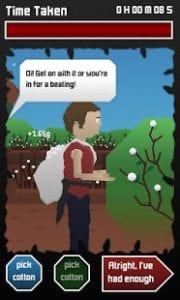A game is not always just an entertainment pastime. Although most of my students interested in game design come to the field on a quest to build quests–epic battles that with 100 hours worth of content, millions of choices embedded in a saga, and lots and lots of elves–many will eventually devote time on games that improve the world in different ways.
game is not always just an entertainment pastime. Although most of my students interested in game design come to the field on a quest to build quests–epic battles that with 100 hours worth of content, millions of choices embedded in a saga, and lots and lots of elves–many will eventually devote time on games that improve the world in different ways.
Serious games are games with a purpose beyond entertainment–they can be large, dedicated setups like the simulations used to train harbor masters directing dock traffic at major seaports or can be small games designed to make one quick point that might raise awareness.
Games are effective for many purposes because story is the common currency of the human brain. Although we often think of story as exclusively an expressive or entertainment, story can convey information in a variety of ways. Narratives are often arguments–Uncle Tom’s Cabin, Dr. Mona Hanna-Attisha’s account of the Flint water crisis in What the Eyes Don’t See, or the story of every grade school kid explaining exactly why they had no choice but to sock that kid in the eye and it was NOT their fault. We use stories to convince others to accept our point of view.
The game to the right is “My Cotton-Picking Life,” a game that can be played in less than a minute, but one that has been designed to do some work. After the user is told that cotton in Uzbekistan is hand-picked by child laborers, the user is invited to play. To play, the user clicks on the blue and green buttons at the bottom of the screen, which manipulates the arms. If the user stops for a few seconds, a speech bubble appears threatening a beating. When the player surrenders (it is boring to perform this small repetitive task even though it is not physically demanding), they are reminded that the real children cannot quit, and then we are given a score. I played with intense and complete focus for one minute and was told I had collected 0.3% of my required quota, meaning that it would have taken me over 5 hours of working as hard as I could to complete the task.
Obviously, the designers of the game do not expect their audience to devote 5–7 hours clicking 2 buttons in order to beat this game, so what are their goals? When I present this game to my students (because I will design an assignment asking them to analyze a game with a persuasive intention), I expect most of them will point to the button that allows you to donate money, but the purpose of this game starts way before anyone decides to donate. Most players will not give funds, but they will walk away with information they never had before: how many people in Johnson County knew they grow cotton in Uzbekistan? Or that they pick it by hand? Or that child labor laws do not exist? And the designers know that before they can get money or action from their audience, first they must achieve awareness.
 Other persuasive games are extremely complex. In The McDonalds Game (http://www.mcvideogame.com/) created by La Molleindustria in 2006. The game has four zones for the player to manage: farmland, the slaughterhouse, the restaurants, and the marketing/lobbying section of the corporation. The player is required to balance the interests of the company with personal values in a series of moral choices (you need more produce from your farmland in Brazil? — do you want to tear down rain forest or buy up farms that sustain indigenous people? Shoud you increase beef production with hormones? It will cost you some public support, but you can fix that with the marketing team. This game has layers of information and wants to persuade the audience’s views about land policy, livestock ethics, corporate policy, international trade, political influence, and other things–but ultimately, they also want to influence the individual’s choice as to whether or not they turn in at that drive-thru.
Other persuasive games are extremely complex. In The McDonalds Game (http://www.mcvideogame.com/) created by La Molleindustria in 2006. The game has four zones for the player to manage: farmland, the slaughterhouse, the restaurants, and the marketing/lobbying section of the corporation. The player is required to balance the interests of the company with personal values in a series of moral choices (you need more produce from your farmland in Brazil? — do you want to tear down rain forest or buy up farms that sustain indigenous people? Shoud you increase beef production with hormones? It will cost you some public support, but you can fix that with the marketing team. This game has layers of information and wants to persuade the audience’s views about land policy, livestock ethics, corporate policy, international trade, political influence, and other things–but ultimately, they also want to influence the individual’s choice as to whether or not they turn in at that drive-thru.
Games like My Cotton-Picking Life and The McDonald’s Game can be found in many places, including the links below: